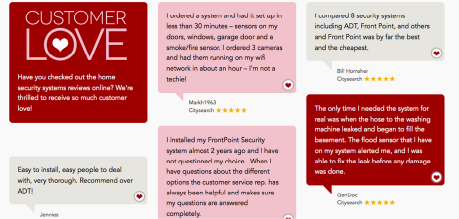 |
| FrontPointSecurity’s Customer Love page on its website is a prime example of how to brand and highlight positive reviews. Company communicators feel that reviews are more effective than advertising. |
As the practice of digital communications has matured, businesses and the public have become more comfortable in digesting information from strangers online. There’s a subset of this practice that could be likened to the Wild Wild West: customer reviews.
In October, customer reviews came to the media forefront when review platform Yelp announced that it was adding a “consumer alert” to some band profile pages that states: “We caught someone red-handed trying to buy reviews for this business.”
In addition, of more than 30 million reviews, reported The New York Times, for every five new notices that are submitted to Yelp, one is determined by internal filters to be so dubious—either highly favorable or highly critical—that it is banned to a secondary page.
Given these developments, as a communicator, review platforms like Yelp, Google Local, Angie’s List and others may seem more trouble than they’re worth. But as PR News found out, by setting up a review process, monitoring the reviews carefully and linking them to sales, they can be an integral and cost-saving part of the PR mix. In addition, we explored an inviting alternative to customer reviews: the customer testimonial.
ON REVIEW POINT
FrontPointSecurity, a home security system provider, has always relied on customer reviews on major social network sites such as Yelp and Angie’s List, says John McNeilly, brand reputation manager, FrontPointSecurity.
“We listen, respond to and track every online review as a committed corporate strategy,” he says. And there’s a reason for that: In surveying customers the company found that 96% of them relied on reviews before making a purchase. In fact, the company feels that customer reviews and responses to them helps sell their products more effectively than advertising.
This is a result of having a focused customer review program, says Cassandra Dobkins, director of social media at FrontPointSecurity.
Here’s how the program works: To encourage customers to write reviews about their experiences, they are enrolled in an e-mail campaign that directs them to review portals. Messaging is also included on product packaging.
Once reviews get written and are up on a particular portal, all monitoring and responses go through Dobkins’ social media team. Then they get fielded out to different departments for action.
Dobkins recommends using a variety of review portals, because good review or bad, you need to be where your audience is. Here are some of her thoughts on the portals used by FrontPointSecurity:
• Yelp: The company has 50 geographic locations set up on Yelp. The beauty of Yelp, says Dobkins, is that if you’re a potential customer in Dallas, you’ll be able to see some 200 reviews originating from other locations like Washington, D.C.
• Angie’s List: It’s different from other review platforms because it’s a paid-for service.FrontPointSecurity has 800 reviews on Angie’s List versus 80 reviews or less for competitors, says McNeilly.
• Google Local: An important platform for the company, yet there’s one drawback: Often accounts and user names are anonymous, so you can’t track down those reviewers down to talk to them offline.
• BBB: This is a portal you don’t want to be on. FrontPointSecurity doesn’t avoid it, though, working with customers to resolve problems.
Dobkins warns of the “snowball customer,” one who moves from platform to platform to spread a bad review. This is where response time is critical, she says. The quicker you respond, the less chance of a snowballing review.
TESTIMONIAL TWIST
One way to to keep things from snowballing is to focus on testimonials—a process in which you know good things will be said about your brand.
John Wolf, CMO of Knowlagent, a maker of call center software, says that testimonials are a big part of the PR mix. The big challenge: a reluctance by customers to reveal call center strategies for competitive reasons, says Wolf. Therefore, getting testimonials is akin to “hand-to-hand combat,” he says.
It starts with the contract. Knowlagent tries to get the customer to agree to multiple levels of publicity—from a press release announcing the relationship to filming a short video testimonial to creating a white paper featuring that customer. Once customers get comfortable with the company’s products over time, they may be more willing to take the testimonial leap, says Wolf.
The company’s communications staff recently created two video testimonials with clients. These professionally shot videos, which take a few hours at most to film, are becoming more popular than one-page white papers.
MEANINGFUL METRICS
But can Wolf tie these testimonials to sales? The key metric is how the testimonial drives conversions on the website. Prospects who view the videos convert 81% more than prospects that didn’t view the testimonials, says Wolf.
At FrontPointSecurity, the communications team has devised an algorithm that combines reviews with letter grades, the results of regular customer surveys and the number of complaints in a set period.
At these B2B and B2C companies, reviews and testimonials play key roles in the sales process, all the more reason for other organizations to develop similar programs. PRN
CONTACT:
John McNeilly, [email protected]; Cassanda Dobkins, cassandra.dobkins; John Wolf, [email protected].
Follow Scott Van Camp: @svancamp01
